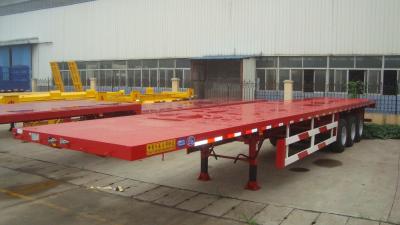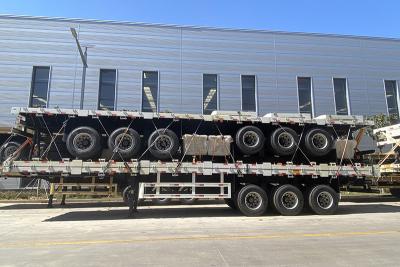Causes of tire wear of semi-trailer
1. Introduction the present situation
With the improvement of the highway and its infrastructure and the rapid development of the national economy, the demand for semi-trailer with high transport efficiency is growing rapidly in recent years.
Among the components of the semi-trailer, the tire is the only component of the vehicle that directly contacts the road surface. It not only bears the weight and dynamic load of the whole vehicle, slows down the impact, and ensures the driving smoothness of the semi-trailer, but also ensures good adhesion, braking, trafficability and safety between the wheel and the road surface.
Under various road conditions and climatic conditions, the working environment of tyres is changeable and harsh. Therefore, it is of great significance to clarify the causes of tyre wear and take active and effective preventive measures for the economy and safety of semi-trailer driving.
The main factors that determine the performance of semi-trailer tyres are as follows: whether the position of the leaf spring seat is correct; Whether the center position of traction pin is accurate; Whether the joint surface of traction steering mechanism is stable; Whether the load distribution of semi-trailer is reasonable; Whether the left and right adjustment levers of semi-trailer are properly adjusted. The wear and preventive measures of semi-trailer tyres are discussed below from the perspective of inspection, use and maintenance.
2. Analysis of the causes of semi-trailer tire wear
2.1 Incorrect position of leaf spring seat
The normal position of the leaf spring seat means that its perpendicularity to the axis of the central hole and the longitudinal axis of the semi-trailer frame shall not be greater than 3 mm, and its symmetry to the longitudinal axis of the frame shall not be greater than 5 mm, otherwise, the central axis of the semi-trailer wheel axle will always form an included angle with the longitudinal axis of the semi-trailer, so that the rolling direction of the tires on the semi-trailer axle will always form an included angle with the driving direction of the semi-trailer, so that the tires cannot roll purely on the ground during driving, However, there is sliding phenomenon.
This phenomenon of rolling and sliding will bring a lateral component to the tractor, leading to vehicle deviation. In order to overcome the deviation of the vehicle, the driving direction must be corrected at all times when the vehicle is driving. This result not only leads to eccentric wear of semi-trailer tires, but also causes abnormal wear of tractor tires.
2.2 The center position of semi-trailer towing pin is inaccurate
The center of semi-trailer traction pin is not on its longitudinal symmetry plane, and eccentric wear of semi-trailer wheels will occur due to the offset of its center of mass. At the same time, the deviation of the traction pin center will cause the axle axis of the semi-trailer not to be perpendicular to the longitudinal symmetry plane of the semi-trailer. At this time, due to the effect of air resistance and ramp resistance, the ground will generate an additional lateral force corresponding to it on the wheel, resulting in additional tire wear.
2.3 Semi trailer traction steering mechanism is unstable
The semi-trailer traction pin connects the tractor with the semi-trailer through the connection with the pin hole of the drawbar. There are active gaps and worn gaps at the connection parts. If the gap is too large, the semi-trailer will impact back and forth and swing left and right during driving. In addition, the uneven contact between the upper plate of the semi-trailer and the contact surface of the drawbar will make the semi-trailer have a twisted friction contact between its tire tread and the road surface during driving and steering, When the tire crown contacts the ground, the friction is concentrated locally, so the wear is accelerated.
2.4 Uneven load distribution of semi-trailer
Generally, when the tire load increases, the tire deformation increases, which increases the deformation and stress of various tire components, causing faster tire wear and reduced life. For the same half of the trailer, the tires with high load wear faster, and the tires with low load wear slower. As far as a single tire is concerned, the side with high load wears fast, while the side with low load wears slowly. In a word, as long as there is a load difference, there will be uneven tire wear, and as long as there is overload, there will be excessive wear.
2.5 Improper adjustment of left and right adjusting rods of semi-trailer
For the elastic balanced semi-trailer with one line and two axles, the difference between the dimensions of the left and right adjusting pull rods shall not be greater than 3mm, otherwise, the axle center lines of the semi-trailer with two axles will not be parallel, and the non perpendicularity error between the axle center line of the semi-trailer and the longitudinal symmetry line of the frame will increase. The increase of this error will cause tire sideslip and lead to eccentric wear of wheels. In addition, because the two axles of the semi-trailer are not parallel, the axle load of the semi-trailer will be uneven, and the tire wear on the two axles will be inconsistent.
2.6 Other influencing factors
In addition to the above factors, there are many other factors for semi-trailer tire wear, such as:
a. The tire pressure is too low, the tire crown shoulder is on the ground, and the shoulder wear is accelerated due to the central camber. When the tire pressure of twin tires is too low, the two sidewalls will scratch and wear each other due to severe sidewall deformation.If the tire pressure is too high, most of the area where the tire contacts the ground is the middle of the tread. At this time, the wear of the middle of the tread is accelerated.
b. If the vehicle speed is too high, the frequency of the tire under load is high and the friction is enhanced. When the working temperature and air pressure of the tire increase and the vehicle speed is too high, the tire will slip on the road and accelerate tire wear.
c. The tire temperature is too high, resulting in rubber cracking, aging and increased wear.
d. Emergency braking is frequent, and the tires change from rolling to dragging, which makes them skid with the road surface and cause excessive wear due to overheating.
e. Excessive road camber will also cause eccentric wear
f. Incorrect tire installation may cause abnormal tire wear due to dynamic (static) imbalance.
The tyres have not been rotated for a long time


